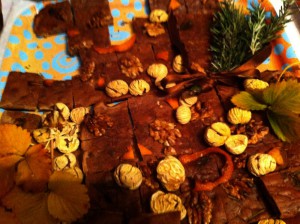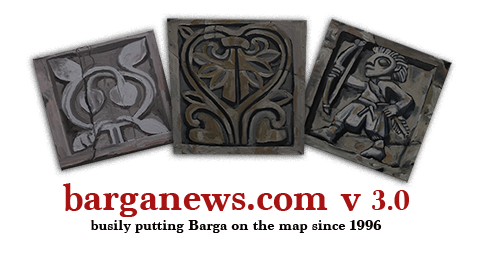 The third annual Castagnaccio contest took place in Barga Vecchia this evening (the first contest 2010 can be seen here, 2011 is here )
The third annual Castagnaccio contest took place in Barga Vecchia this evening (the first contest 2010 can be seen here, 2011 is here )
In 2010 there were just 6 contestants fighting it out for the honour of preparing the best traditional castagnaccio – the classic sweet dish from this area made from chestnut flour.
Last year there were 13 battling it out and this year it was a fiercely contested Trofeo Castagnaccio with 19 entries.
Thanks to the work of the organisers, the Lake Angels, it is once again a strictly controlled event with no names on the plates just numbers with people casting their votes for which in their opinion is the best.
As members of the Aristos band played in the background, the votes were counted and the final winner announced to one and all.
Last year it came as little surprise to anybody in the bar when it was announced that Natale Bertolini was awarded this year’s best Castagnaccio 2011.
Natale Bertolini, the maestro of all things chestnut has been producing castagnaccio from his oven for the past half a century, his skill is widely known in the valley and once more he has proved it by winning for the second year running the Trofeo but coming up close on his heels was his daughter in law, Tiziana Faccio who took the second prize and then the the women from the Altana restaurant who took the third.
But that 2011 – how would things change for 2012?
[wunderslider_nggallery id=”2620″]
First of all. Natale did not participate this year due to ill health but his grand daughter Camilla took third prize keeping it in the family so to speak . The Altana restaurant took first prize and Maria Assunta took the second place.
A word maybe should also be said about an entry from Garfagnana using dried chestnuts and leaves by Cinzia Lenzarini – it did not win the Trofeo Castagnaccio but drew special mention from the judges for the presentation of her castagnaccio.
The humble sweet chestnut has been an important ingredient in the Mediterranean diet – Homer mentions them, and Pliny even says which kinds were grown in Southern Italy. With time their cultivation spread throughout the peninsula, because they were one of the few food crops that could be grown on steep mountain slopes, and also one of the few crops that could be expected to provide sustenance through the long winter months.
By the middle ages castagne were the staple food of the peasants in large parts of Italy. In this area it has been the saviour of many people who otherwise would have starved when times got really bad and the sweet chestnut flour is still known to this day in Garfagnana as “poor mans flour”
This afternoon I tried my hand at one of the most easiest and tastiest dishes from Garfagnana and Barga – Castagnaccio The classic sweet dish from this area made from chestnut flour
I sifted 250 g of chestnut flour (good quality chestnut flour from one of the local mills at Fosciandora in Garfagnana) into a large bowl with a good pinch of salt and slowly added 200 ml of water and 200 ml of milk – the added milk does change the taste and the colour of the final castagnaccio .. (the original recipe would have been just 400 ml of water)
I stirred the mix until it was a good liquid batter.
I preheated the oven to 180° and prepared with butter the inside of a large flat oven dish.
I poured the mixture into the dish and sprinkled on top, a good couple of handful of walnuts, some pine nuts, sliced orange rinds* and a few springs of rosemary.
A couple of teaspoons of olive oil sprinkled across the top and into the oven for 40 minutes.
Cut into slices and hey presto in less than 40 minutes from start to finish – Castagniaccio.
Ingredients
250 g of chestnut flour
200 ml of water
200ml of milk
walnuts
pine nuts
sliced orange peel
rosemary
olive oil
salt
* Ok so I cheated a bit with the sliced orange peel. To add just that extra hit of sweetness, I heated them briefly in a small pan in some of the juice of the orange and added two small spoons of sugar to caramelise them. Naughty I know.


1 Response